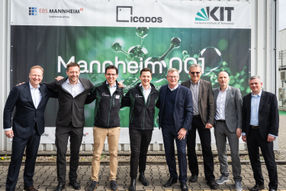Höchst Industrial Park: Carbon capture pilot plant goes into operation
Project by Infraserv Höchst and GEA
Advertisement
Infraserv Höchst has successfully commissioned a carbon capture pilot plant at Industriepark Höchst's sewage sludge incineration facility to gather data and experience on the feasibility of capturing CO₂ from flue gases. The pilot plant was supplied by GEA, a leading global provider of process technologies and sustainable industrial solutions. Infraserv Höchst is renting the plant for a period of three months.
Important contribution to the transformation of Industriepark Höchst
"Pilot plants of this kind are indispensable for testing the process and collecting the necessary data," explained Dr. Joachim Kreysing, Managing Director of Infraserv Höchst. This is the prerequisite for being able to operate our own, larger carbon capture plants at Industriepark Höchst in the future. "Carbon capture can make an important contribution to the site's sustainable transformation if the technical, economic and regulatory conditions are right." Carbon capture helps to reduce CO₂ emissions, conserve fossil resources and promote the circular economy. "We want to create the best conditions at Industriepark Höchst to enable our customers to move towards sustainability. That includes the various ways to use CO₂," said Dr. Kreysing. Infraserv is continuously exploring the market to identify potential customers for captured CO₂.
Separating CO₂ from flue gases is challenging
As part of the project, a partial flow of flue gas is extracted from the chimney at Infraserv Höchst's sewage sludge incineration plant in order to scrub out and separate the CO₂ it contains in the pilot plant. This poses a particular challenge because the flue gas from an incineration plant contains many different components. The test phase is therefore crucial in order to gain experience and test the feasibility of CO₂ separation with regard to various parameters. Data is collected on the capture rate, the purity of the CO₂, the decomposition of the scrubbing agent used to bind and capture the CO2and the energy requirement. "Essentially, we are evaluating the energy requirements, efficiency and costs of a large-scale separation system at an incineration plant," explains Dr. Sirko Ogriseck, Project Manager at Infraserv Höchst. The sewage sludge incineration plant was deliberately chosen because part of the CO2is of biogenic origin. In the future, Infraserv would like to supply this CO2to startups so that they can use it in their syntheses together with low-carbon energies such as green hydrogen and green electricity. Biogenic CO₂ plays a key role in carbon capture and utilization (CCU), i.e. the chemical use of carbon dioxide, because unlike fossil CO₂, it is considered climate-neutral - it comes from renewable raw materials and was previously removed from the atmosphere by plants. As a result, biogenic CO₂ enables the climate-neutral production of chemical products, fuels and materials whose CO₂ balance would otherwise be negative,and supports the transformation of the chemical industry towards a greenhouse gas-neutral circular economy.
The process of CO₂ capture by the GEA pilot plant
"At the waste incineration plant, a partial flow of flue gas is extracted from the stack. This flue gas is fed into the pilot plant. During CO₂ capture with amines, the CO₂ is washed out of the flue gas," says Michael Schneider, R&D Engineer Carbon Capture Solutions at GEA, explaining the CO₂ capture process. "The flue gas is brought into contact with a liquid, an amine-water mixture, which absorbs the CO₂. This liquid is then heated so that the CO₂ is released again." The CO₂ separated from the flue gas is examined for its purity and operating data from the CO₂ separation is collected in parallel. "After separation in the pilot plant, the CO₂ could be purified and processed further, but this is not part of the project. Currently, after treatment in the pilot plant, the CO₂ is fed back into the chimney of the waste incineration plant," explains Schneider.
Captured CO₂ for the production of synthetic fuels
Carbon capture and utilization (CCU) is nothing new for Infraserv Höchst. Several years ago, the CO2captured at the industrial park's biogas treatment plant was processed into emission-free oils and waxes in the ICO2CHEM research project in collaboration with partners. Infraserv now supplies this CO2to INERATEC's largest power-to-liquid pioneer plant in Europe, which was recently put into operation. This plant converts CO₂ into synthetic fuels such as e-kerosene in combination with hydrogen.





























































